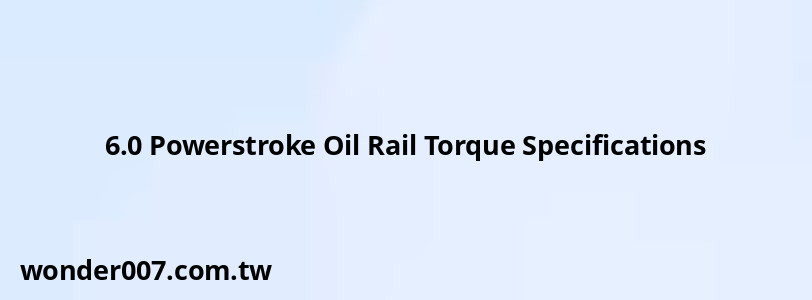6.0 Powerstroke Oil Rail Torque Specifications

The 6.0 Powerstroke engine's high-pressure oil rail system is crucial for proper fuel injection and engine performance. Correct torque specifications are essential when working on this component to ensure proper sealing and prevent oil leaks. Here are the key torque specifications and procedures for the 6.0 Powerstroke oil rail:
High-Pressure Oil Rail Bolts
The high-pressure oil rail bolts require a specific torque sequence and value:
- Torque specification: 96 inch-pounds (11 Nm)
- Torque sequence:
2. Press the rail down until seated
3. Install remaining bolts and torque to 96 inch-pounds in the following sequence:
6 - 1 - 4 - 2 - 8 - 7 - 3 - 5
It's crucial to follow this sequence to ensure proper seating and even pressure distribution across the rail.
Stand Pipes and Dummy Plugs
The stand pipes and dummy plugs, which connect the oil branch tubes to the rails, also have specific torque requirements:
- Stand pipe torque: 33 ft-lbs (45 Nm)
- Dummy plug torque: 60 ft-lbs (81 Nm)
Ensure to use new O-rings when replacing these components, as they are prone to leaks.
High-Pressure Oil Rail Check Valve
The check valve in the high-pressure oil rail system should be torqued to:
- 25 ft-lbs (34 Nm)
Oil Rail Plug
For the high-pressure oil rail plug (M14 size):
- Torque specification: 33 ft-lbs (45 Nm)
Important Considerations
When working on the 6.0 Powerstroke oil rail system:
- Always use new bolts when reassembling the oil rail
- Clean all threaded holes thoroughly to prevent false torque readings
- Apply a small amount of clean engine oil to bolt threads before installation
- Use a calibrated torque wrench for accurate torque application
- Inspect all O-rings and sealing surfaces for damage before reassembly
Following these specifications and procedures will help ensure proper sealing and operation of the high-pressure oil system in your 6.0 Powerstroke engine.
Additional Tips
- When removing the oil rail, be cautious not to damage the injector fittings or branch tubes
- If you're experiencing high-pressure oil leaks, inspect the stand pipes and dummy plugs first, as these are common failure points
- Consider using guide pins to help align the oil rail during reinstallation
- After reassembly, run the engine and check for leaks before considering the job complete
By adhering to these torque specifications and best practices, you can maintain the integrity of your 6.0 Powerstroke's high-pressure oil system and prevent potential issues related to improper assembly.
FAQs About 6.0 Powerstroke Oil Rail Torque
- Can I reuse the old oil rail bolts?
It's not recommended. Always use new bolts to ensure proper clamping force and prevent leaks. - What happens if I over-torque the oil rail bolts?
Over-torquing can lead to stripped threads, damaged components, or improper sealing, potentially causing oil leaks or engine damage. - How often should I check the oil rail for leaks?
It's a good practice to visually inspect for leaks during regular oil changes or any time you're working on related engine components. - Do I need special tools to work on the 6.0 Powerstroke oil rail?
While most work can be done with standard tools, a good-quality torque wrench is essential for proper assembly.
Related Posts
-
Hyundai Sonata: 2014 Lug Nut Size and Specifications
30-01-2025 • 188 views -
Torque Specs for Valve Cover Bolts: Essential Guide
30-01-2025 • 208 views -
Hyundai Sonata: 2011 Lug Nut Torque Specifications
28-01-2025 • 175 views -
Schrader Valve On The Fuel Rail: Essential Guide
26-01-2025 • 191 views -
2004 Toyota 4Runner: Essential Torque Specifications
29-01-2025 • 179 views
Latest Posts
-
Rear Brake Caliper Piston Won't Compress
01-02-2025 • 356 views -
Are O2 Sensors Covered Under Warranty
01-02-2025 • 376 views -
How To Turn Off Paddle Shifters Mercedes
01-02-2025 • 377 views -
2015 Chevy Traverse AC Recharge Port Location
01-02-2025 • 409 views -
Power Steering Fluid Leak On Passenger Side
01-02-2025 • 457 views
Popular Posts
-
Hino Warning Lights: Understanding Dashboard Alerts
26-01-2025 • 765 views -
V12 Engine Costs: What You Need to Know
26-01-2025 • 679 views -
EPC Light: Understanding Causes and Solutions
26-01-2025 • 1053 views -
Power Steering and ABS Light On: Causes and Solutions
27-01-2025 • 643 views -
EPC Warning Light: What It Means for Your Vehicle
27-01-2025 • 630 views
